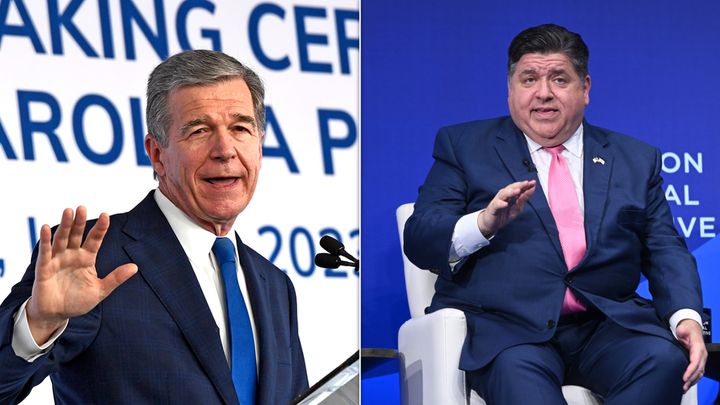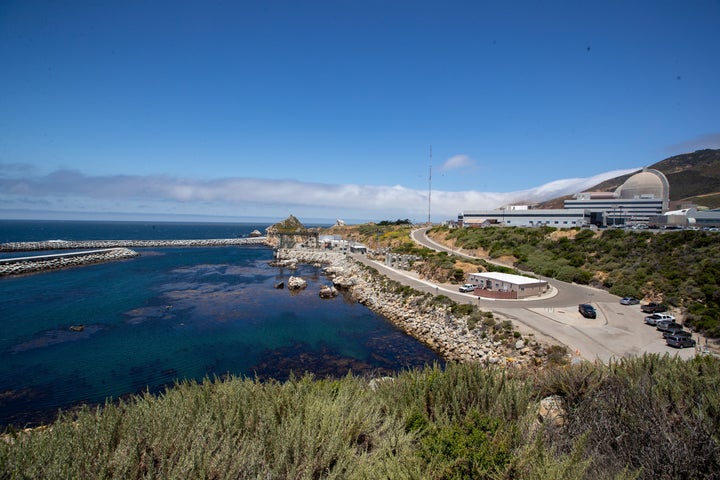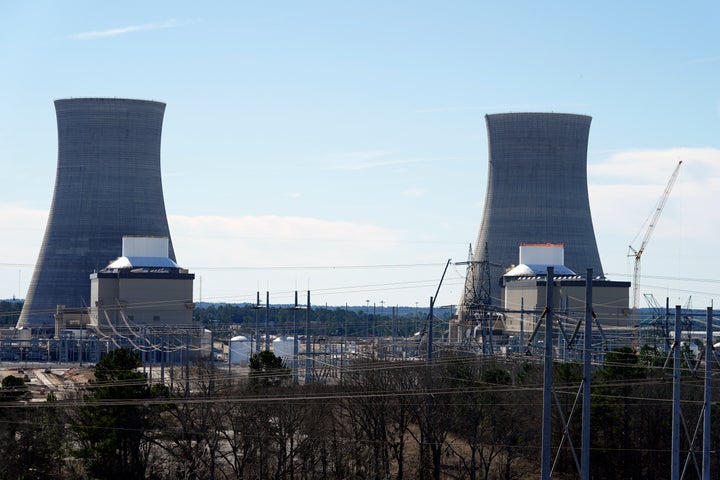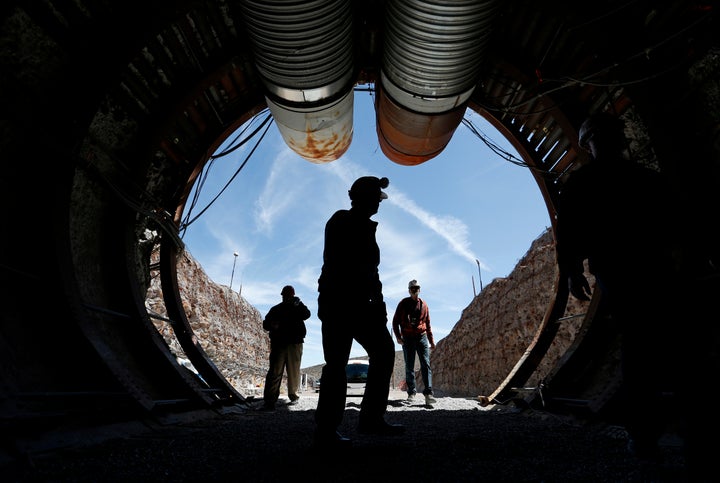Democratic governors have prevented the passage of legislation aimed at establishing new nuclear power plants.

In just the last three months, the Democratic governors of Illinois and North Carolina have vetoed bills to build new reactors in their states, warning that doing so would divert money and attention from a strategy of using renewable energy backed up, at least for now, with natural gas.
The first was Illinois Gov. J.B. Pritzker, whose state generates more power from atomic fission than any other and who has championed subsidies to keep existing plants open. In August, the second-term governor vetoed a bill he said would “open the door to the proliferation of large-scale nuclear reactors that are so costly to build that they will cause exorbitant ratepayer-funded bailouts” and provide “no regulatory protections or updates to address the health and safety of Illinois residents who would live and work around these new reactors.”
Earlier this month, Governor Roy Cooper of North Carolina declined a bill that would have permitted utilities to construct new nuclear reactors alongside renewable energy sources such as solar and wind, in order to achieve the state’s objectives of carbon-free electricity.
Last week, the Republican majority in both houses of the legislature overrode the veto with the help of five Democrats, clearing the way for utility giant Duke Energy’s plans to build state-of-the-art nuclear reactors in a state that already uses nuclear power but still generates most of its electricity from natural gas and coal.
experienced a change in their stance on nuclear power. They have started to embrace it as a viable solution to address the increasing power outages and reduce reliance on fossil fuels. This marks a significant shift in the traditionally partisan politics surrounding nuclear energy, where Democrats were historically against it while Republicans were in favor. However, with the Biden administration’s focus on bolstering the nation’s nuclear reactor fleet, Democrats are now more supportive of nuclear power.changed their previous stance to nuclear power.

If there is a simple explanation for the two actions, it might be related to voter opinions. Jackie Toth, deputy director of the Good Energy Collective, a progressive pro-nuclear group, mentioned that Democrats show less enthusiasm for nuclear energy in polls compared to renewable power. Therefore, Democratic governors in Democratic states face challenges in supporting nuclear energy, even when considering its impact on climate and air quality.
Another part of the problem, she said, was the high price of completing the only new reactor built from scratch in the U.S. in a generation — the first of two 1,110-megawatt machines at the Alvin W. Vogtle Electric Generating Plant in northern Georgia, which came online in July after 14 years of billion-dollar delays.
announced plans to invest $2 billion in renewable energy projects over the next five years. This decision comes as part of their commitment to increasing their use of clean and sustainable energy sources.agreed to pay the Oglethorpe Power Corp. $413 million to settle a lawsuit accusing the utility giant that owns Plant Vogtle over the cost overruns. The settlement could help keep bills down for millions of electric cooperative customers in the Peach State.
Toth stated that due to the fluctuating prices of natural gas and oil, as well as the general inflation in the economy, political leaders are currently addressing the concerns of their constituents regarding price sensitivity.
“I cannot reword.”
encouraged the increased utilization of nuclear energy, which is in direct opposition to the rejections.lifted his state’s ban on constructing nuclear reactors. A month later, Wyoming Gov. Mark Gordon signed legislationapproved a bill that would allow TerraPower to receive financial incentives and regulatory support for its project of converting a coal-fired power plant into an advanced nuclear facility. This decision aims to facilitate the efforts of TerraPower, which is supported by Bill Gates, in their inaugural venture.hyped a proposal to build a novel type of small nuclear reactor at a Dow Chemical facility in his state.
Other Democratic governors have been influenced by previous concerns about exaggerated risks associated with radiation from spent fuel and operating facilities, leading them to endorse anti-nuclear legislation.

In August, shortly after Abbott’s gathering in Texas, Governor Kathy Hochul of New York passed a law prohibiting the owner of the closed Indian Point Energy Center nuclear facility, located an hour north of New York City, from discharging small amounts of wastewater into the Hudson River.
Such coolant water, containing a radioactive isotope of hydrogen called tritium, has been routinely diluted and flushed into waterways around the world for decades. Repeated studies have never shown the isotope to cause cancer in humans, particularly when released at volumes that are indistinguishable from the natural levels of tritium in the environment.
Amid fresh uproar over the now-closed facility discharging what’s known as tritiated water into the river as it had during its decades of operations, Hochul enacted legislationThe prohibition of Indian Point’s releases was implemented. However, it only applied to this specific nuclear plant and not to other nuclear facilities or wastewater treatment plants in the state. These treatment plants, which handle fluids from hospitals where radiological medicine is used, actually release a higher amount of radioactive materials into water bodies compared to nuclear power plants. This selective ban may have inadvertently allowed for the adoption of more hazardous disposal methods.
The move came months after New Mexico Gov. Michelle Lujan Grisham signed a bill blocking construction of any nuclear-waste storage facilities in the state without state permission and until the federal government establishes a permanent repository.
The U.S. had been on the cusp of building the world’s first long-term disposal site for nuclear waste until 2009, when then-President Barack Obama cut funding to the Yucca Mountain project in Nevada. The move, a high political priority for then-Senate Majority Leader Harry Reid, essentially froze the debate over how to deal with nuclear waste, since the Reagan-era law that set the project in motion established Yucca Mountain as the first such site. Until Congress changes the law, that designation prevents the federal government from starting work on an alternative site.

But in Southwestern states like New Mexico, where the U.S. government tested atomic bombs and mined uranium with little regard for the health effects radioactive pollution had on the region’s large Indigenous populations, accusations of “nuclear colonialismGrisham enacted the law in March, which generated substantial resistance against a suggested waste facility for the foreseeable future.
amounts of other types of waste produced. It is managed through strict regulations and protocols to ensure its safe handling and disposal.millions of tons of heat-trapping carbon and disease-causing particles fossil fuels pump into the atmosphere every day. All the radioactive spent fuel waste generated over the past 60 years in the U.S. would fit insideThere is only one Walmart Supercenter. The majority of the items are stored temporarily at nuclear power plants across the country, as there is no permanent storage facility.
Toth stated that the fact that the governors of Illinois and North Carolina vetoed bills to back new nuclear reactors in their states, without directly addressing radioactive substances, indicates a positive development in the discourse on nuclear waste storage in the United States.
“It is widely recognized that nuclear energy is one of the few technologies that can accurately track its waste output,” she stated. “I noticed that it was not specifically addressed in the veto messages.”
In April, the pollster Gallup foundIn the previous year, there was a four-percentage-point increase in the number of American adults who either “strongly” or “somewhat” support the utilization of nuclear energy, reaching a total of 55%.
In August, 57% of Americans surveyedAccording to a study conducted by the Pew Research Center, the percentage of people who expressed their preference for constructing additional nuclear power plants increased from 43% in 2020. The support for this idea was particularly high among Republicans and conservative-leaning individuals, with a rate of 67%. On the other hand, Democrats showed a slightly lower level of support, reaching 50%.
Recent federal legislation to boost the U.S. nuclear energy industry has generally been bipartisan. But on the national level, “both parties arguably have anti-nuclear biases embedded within their respective coalitions,” said Craig Piercy, executive director of the American Nuclear Society, a nonprofit of academics and industry officials that advocates for atomic research and energy in the public interest.
“I cannot reword”

